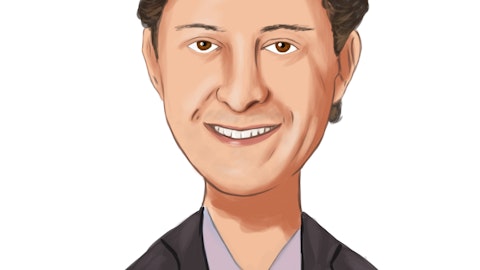We’re not in that situation. We had — you can see from the rebound, even though we have forecasted in conservatively, we are confident today, as I said in my remarks, that alignment on the pricing side with these cost trends, we feel good about. So to the degree that we’ve had some dampening effect to gross profit this year from benefits, we don’t see that into next year. However, that’s only one component of the whole direct cost picture. And so we’re not at a point of being that specific about next year. But in terms of the big picture, our comfort on the gross profit level is better than what we went through this year and we’ll be digging in on details on price and cost and all of our components as we plan into next year, and we’ll be providing specifics, of course, on our next call for guidance.
Douglas Sharp: I think another thing you’re probably aware of is the inflationary environment, is there contract — carrier contract negotiations and pharmacy negotiations. That’s just where we are today in the current environment that we’re working in. And obviously, we’re going to be considering that in our pricing.
Mark Marcon: Can you talk a little bit about what you’re seeing just from a geographic perspective in terms of the net hiring impacts and I’m specifically curious one of your competitors mentioned that particularly in California with tech and professional services, there was a bit of a slowdown with regards to hiring. Wondering if you’re seeing the same thing? And along those lines, I’m wondering if you can also just talk about the increased penetration of the PEO concept and your success in terms of newer, less well-developed markets and what you’re seeing and how that for bodes for the long-term future.
Paul Sarvadi: We really did do some digging down on both the industry and geographic elements related to — and drivers of the flattening of the net change within existing clients. And certainly, we saw areas where the professional and technical is a bigger part of the environment in a given location, we saw that contribute more to this flattening. And that was, of course, both the West Coast and the Northeast. So we saw those 2 regions where we saw the most effect there by in terms of geography. Now in terms of industry category, absolutely professional, technical, was right there. But also, we did see this broaden more over the last quarter or so. And so I think some of the effect that I described in here, the effective interest rates and inflation and the labor market especially the quality of available people in terms of matching the requirements.
Those things are having an effect. We saw that in a deeper analysis of the net pay change. That’s gone down now back to even below some of the average levels of 3% to 4% for average pay increases dropped down a bit. You have those other 2 factors I watch closely, overtime pay as a percent of regular pay, being down below 10%. And then the other that is a really key factor is that commission number. We’re paying these commissions to the sales staff of the clients. That means they’re getting paid based on the sales they’ve made recently. That’s the pipeline for new business at the client location. That’s down pretty significantly especially compared to recent periods, booming periods post-COVID, those numbers were really high. They were — they’ve been decreasing and now gone below that 6% level that we have seen historically as a trigger point above 6%, they would need to hire more people below that, they’re able to hold fast.
So that is reflective. And like I said previously, in answer to another question, that doesn’t mean all the small business community is having that reaction. It’s always a mixed bag, but much of the community is really having to deal with a tougher economic environment. And fortunately, we’re in a business where the demand for what we do is heightened anytime there’s changing going on or pressure going on, they need help. So we are excited about the demand for our services. And you do have to change some of your — some of your messaging to fit more tightly or you have to understand a specific client’s current situation to understand what part of our messaging would connect more to their current going forward plan and how we can connect to helping them in the immediate future.
And so it becomes a little more I wouldn’t say complex, but there’s more thinking you do to really connect with each customer. So — but that’s a good environment for us. We’ve seen this before, and it’s — it really gets us excited. We’re in a business that’s designed to help businesses succeed so communities prosper and they need help in a time like this, and we’re excited to be right shoulder to shoulder with them.
Operator: Your next question is coming from Tobey Sommer of Truist Securities. Tobey, your line is live.
Tobey Sommer: Thank you, Paul and Doug. I wanted to ask a question about your sort of expense and investment posture headed into next year. So not really the inputs to gross profit, but sort of how you’re going to prosecute sales, the investments in the sales force, marketing, the things that you can sort of more directly control. How are you thinking about that at this stage because I know you’re afforded the opportunity and have planned for longer time horizons than I think your average public company.
Paul Sarvadi: Yes, absolutely. We’re in good shape going into next year on the operating expense side. And in the area that you’re describing or asking a question about on the sales side, since we have 13% increase in the size of the staff, our investment in that doesn’t have to be as high as it was over the last year. Also, the last 2 years, we’ve invested more in the incentive system, which now is built into the base of our operations. So I don’t see us having to make an additional investment in that area of the business. So we are able then to do the smart thing, which is make sure our investment is appropriate in the marketing area to provide the activity level needed for our sales team because as they are now another year into their training and development there, sales efficiency number can go up as long as you’re feeding them a good volume of activity.
So I love the position we’re in, going into next year. And then in addition to that, as I mentioned in my remarks, we had to go through a significant recovery or catch up on the service personnel across the company. Again, from the tight labor market and the fast growth. So this year has been a great opportunity to rightsize the staff, be prepared — better prepared for a level of growth but that was also a big investment that I don’t see repeating. We can actually increase staff more in alignment with growth as opposed to what we had over the last year. And also, of course, the Salesforce investment was a significant one. Like I said in my remarks, it’s not like we’re not going to make other investments but not at that level. So I do see a recovery in the operating leverage on that side of the business as we move forward.
Tobey Sommer: If I could ask a follow-up. How are you feeling about pricing and competition, particularly, I think the health care benefit costs are expected to rise next year in the market, sort of rate of growth. And I’m curious in the fall selling campaign how you’re feeling about pricing in competition in the next year?
Paul Sarvadi: Yes, I feel real strong about how we are handling the matching of our allocations going forward, we’ve discussed that. So in terms of the competitive environment, this is a fun time of year for us. I love how we are focused on dealing with these things in the marketplace. And I’m not going to go into detail about that. I just know we’ve got a great plan on that front, and it’s focused, it’s targeted and it’s not an approach that affects our long-term pricing. It’s an approach that affects allowing clients to come on board and almost more of a try and buy approach that is very effective against what we’re seeing in the marketplace. So again, we are more concerned about long-term matching. And I think because we’ve been strong in our pricing up to this point, there may be others in the marketplace that have to respond more quickly, say, on the health care side we’ve been managing that.



